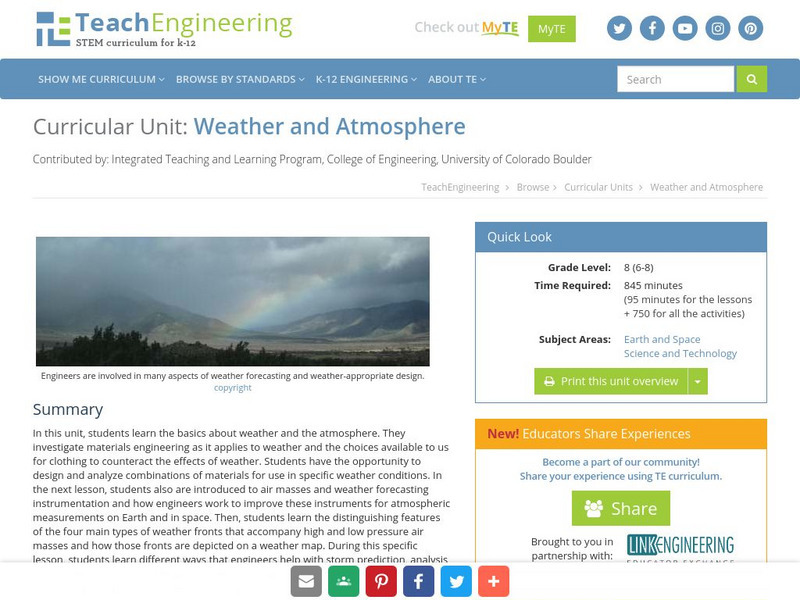Hi, what do you want to do?
Curated OER
Is Grandpa Right, Were Winters Colder When He Was a Boy?
Students compare current weather data to historic data to see if there is a temperature change. In this weather lesson students complete a lab activity and determine average changes in temperature, precipitation and cloud cover.
Alabama Learning Exchange
Researching Hurricanes with Technology
High schoolers explain the components that make up a hurricane.
Curated OER
Volcanoes:How Safe Are They?
Students explore volcanoes, locate them on maps, record general information about volcanoes, and organize information on a fact sheet.
Curated OER
Floods: Rising Waters and You
Students examine the relationship between human-made structures, flood waters and the increasing population through video clips, websites and a lab experiment.
American Museum of Natural History
A Closer Look at Mars
A website looks at how we know so much about Mars—telescopes, robots, and spacecraft—and the search for martian life. Following the informational text are three questions that quiz pupils about possible life on Mars.
Curated OER
Writing the Wind
Students make a windmill. For this wind lesson, students learn background information about the windmill, complete an activity where they create a windmill, discuss using wind as a natural resource and brainstorm other inventions...
Curated OER
Using A Winogradsky Column to Analyze Microbial Communities
Students use easily obtained materials to study ecological succession in a microbiological community. They collect water samples from outdoor sources in plastic bottles to observe and record changes.
Curated OER
Biogeochemical Cycles
Students research an assigned biogeochemical cycle. In this cycle activity, students need to determine that all cycles need energy to continue. The students will look at a given cycle to describe it, research and draw an assigned cycle,...
Curated OER
Let's Get To the Core!
Students practice analyzing ice core samples to discover climate changes. Using the samples, they identify and graph the gas amounts. They use these numbers to determine their effect on global warming. In pairs, they complete a...
Howard Hughes Medical Institute
Hhmi: Bio Interactive: Paleoclimate: A History of Change
Learn about the history of Earth's climate in this Click and Learn. Learn how many factor control Earth's climate. Specifically, examine two of the most important factors: solar radiation and the composition of Earth's atmosphere.
Read Works
Read Works: Passages: "The Rise of Oxygen in the Earth's Atmosphere"
[Free Registration/Login Required] The article "The Rise of Oxygen in the Earth's Atmosphere" from the American Museum of Natural History focuses on when the rise of oxygen in the earth's atmosphere began. A Step Read, a question set,...
Nine Planets
The Nine Planets: Earth Facts
Find lots of information about our planet Earth here. Covers basic facts, Earth's history, layers of the Earth, plate tectonics, composition of the atmosphere, Earth's magnetic field, and some facts about our moon.
Vision Learning
Visionlearning: Atmosphere and Oceans: The Origin of the Modern Atmosphere
An explanation of how the Earth's atmosphere has changed over time. Evidence that helped scientists understand these changes is presented.
Vision Learning
Visionlearning: Atmosphere and Oceans: The Rise of Atmospheric Oxygen
An explanation of the Earth's atmosphere and how it has evolved over geologic time.
Smithsonian Institution
National Museum of Natural History: Paleobiology: The Archaean Eon
Journey into the past while reading this comprehensive overview of the Archaean Eon that covers topics such as early continents and oceans, first life on Earth, Earth's atmosphere, fossil evidence, and plate tectonics.
Other
Digital Library for Earth System Education (Dlese)
This resource provides materials for teachers on a huge array of topics. Search site by topic, grade level, and desired output (such as lesson plan, case study, assessment or tutorial). Site is focused on earth science, geography, and...
Howard Hughes Medical Institute
Hhmi: Biointeractive: Earth Viewer
Watch the earth change with this interactive app? What did Earth look like 250 million years ago? Or 1 billion years ago? Or 4.5 billion years ago? What was the climate like in the deep past? Find the answers with EarthViewer, an...
TeachEngineering
Teach Engineering: Weather and Atmosphere
In this unit, students learn the basics about weather and the atmosphere. They investigate materials engineering as it applies to weather and the choices available to us for clothing to counteract the effects of weather. Students have...
Smithsonian Institution
National Museum of Natural History: Paleobiology: Geologic Time: Hadean Eon
Journey into the past while reading this comprehensive overview of the Hadean Eon that covers topics such as the formation of the earth, its surface and atmosphere, fossil evidence, erosion and plate tectonics.
Annenberg Foundation
Annenberg Learner: Earth and Space Science: The Geologic Timeline
Take this online quiz and test your knowledge of geological history, and the formation of our atmosphere, water, crust, oxygen, tectonic plates, Moon, and the rest of the Earth.
Khan Academy
Khan Academy: Activity: Living in the Extremes of the Biosphere
In this activity, you'll describe what you think it might be like for humans to live in the extremes of the biosphere. Think about the challenges associated with living either underwater or in the upper atmosphere. Also, think about what...
Open Curriculum
Open Curriculum: Into the Mitochondrion: Making Atp With Oxygen
The aim of this article is to relate the history of oxygen in the atmosphere to the evolution of photosynthesis, aerobic respiration, mitochondria, and life on earth.
CK-12 Foundation
Ck 12: Earth Science: Early Atmosphere and Oceans Study Guide
This comprehensive study guide covers the main terms and concepts needed for an earth science unit on the early atmosphere and oceans. Review questions are included at the bottom of the study guide.
Khan Academy
Khan Academy: The Atmosphere and Life
This is an interview between two scientists discussing how shaping the biosphere is due to geologic events and changes in the atmosphere. Learn how there is a "complex balance between Earth's processes and its network of life".
























